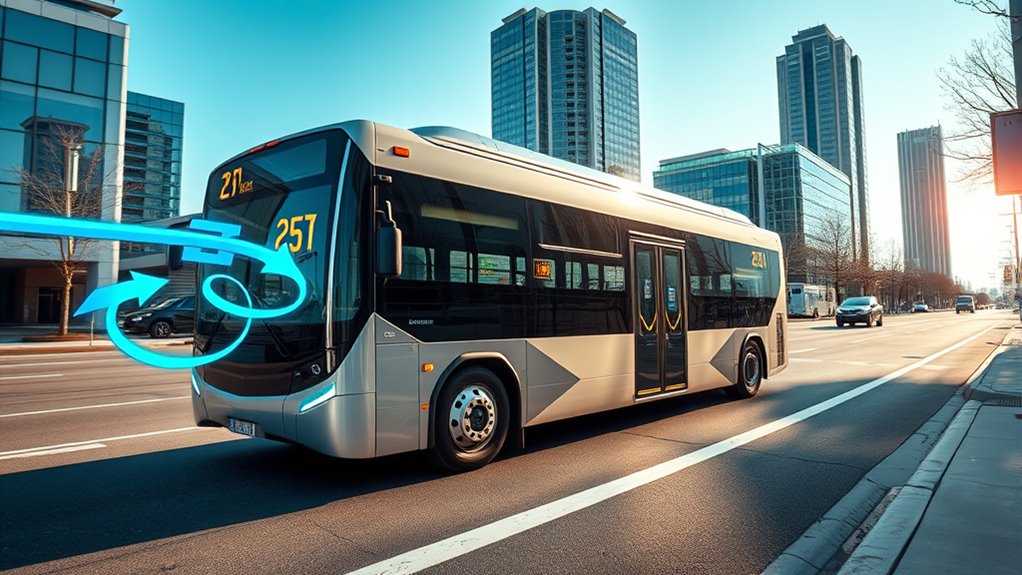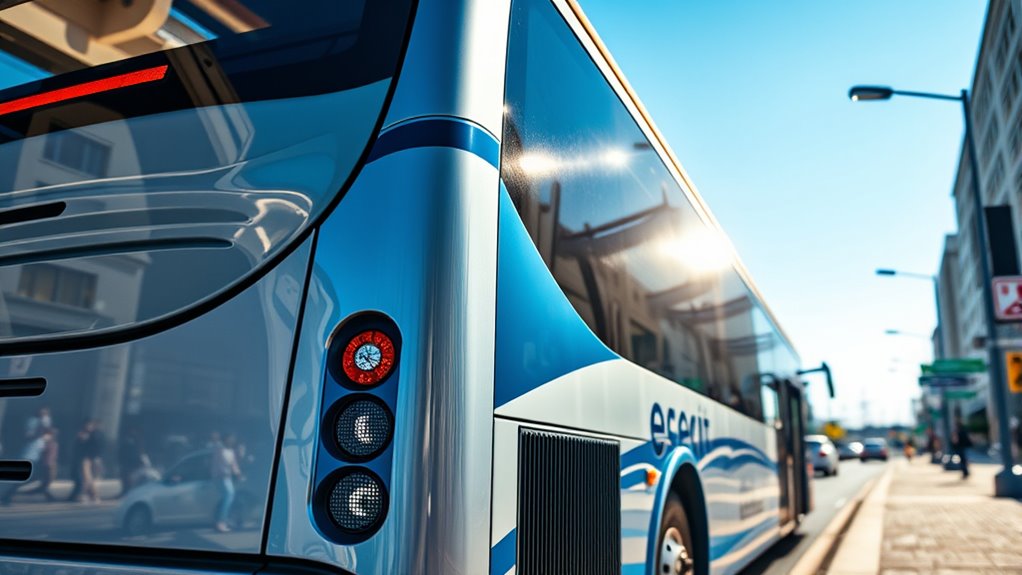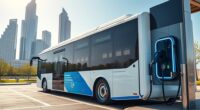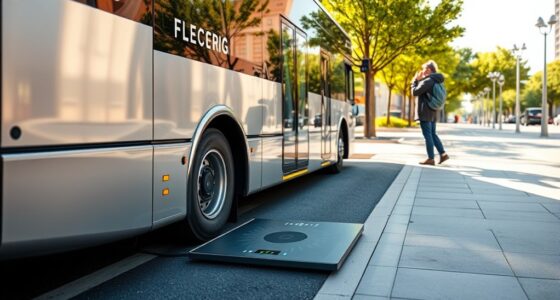In electric buses, regenerative braking works by switching the motor into generator mode when you brake. Instead of wasting energy as heat, the system captures the bus’s kinetic energy and converts it into electrical energy. This electricity is then stored in the high-voltage batteries for later use. The system works alongside regular brakes, helping extend your bus’s range and reduce wear on brake parts. If you want to see more details, there’s plenty more to discover.
Key Takeaways
- During braking, the electric motor switches to generator mode, converting kinetic energy into electrical energy.
- The generated electricity is stored in high-voltage batteries for future use.
- Regenerative braking reduces reliance on friction brakes, decreasing wear and heat generation.
- System efficiency depends on factors like battery temperature and charge level, working best during low to moderate deceleration.
- It extends bus range, reduces energy costs, and supports sustainable, cleaner operation.

Regenerative braking in electric buses transforms the way these vehicles conserve energy during operation. When you step on the brake, the bus’s electric motor switches roles and acts as a generator. Instead of just slowing down through friction, it captures the bus’s kinetic energy—energy normally lost as heat—and converts it into electrical energy. This electricity is then stored in the high-voltage battery system, ready to be reused during acceleration or other power demands.
Regenerative braking captures kinetic energy, converting it into electrical power stored for future use in electric buses.
This process works seamlessly with traditional friction brakes, especially during high-speed stops, but the system prioritizes regenerative braking whenever possible. This means that during frequent stops, like on busy city routes or at traffic lights, you’re effectively recycling energy that would otherwise be wasted. The energy recaptured through regenerative braking greatly extends the bus’s operational range. Because it recovers energy during deceleration, the bus uses less battery power overall, which helps lessen the frequency of charging. This is particularly useful when climbing hills—any downhill segments allow the system to recover even more energy. Additionally, the effectiveness of this system depends on factors such as battery temperature, which can influence how much energy is recovered during braking. Proper battery management can enhance the efficiency of energy recovery and prolong battery life.
As a result, the bus can operate longer between charges, making it more efficient than traditional internal combustion engine (ICE) buses. Plus, this energy recycling reduces the overall energy consumption per mile driven, saving costs and lowering emissions. Another advantage is the reduction of mechanical wear on the brakes. Since regenerative braking handles most of the deceleration, the friction brakes are used far less—up to 90% under ideal conditions. This means less frequent brake pad replacements, less maintenance downtime, and lower costs for brake system repairs.
It also reduces brake dust and particulate emissions, which are common with traditional braking systems. Additionally, with less heat generated from braking, the risk of brake fade decreases, and the lifespan of components like rotors and calipers extends. The system’s integration with other vehicle controls ensures smooth, consistent braking feel, maintaining driver confidence and safety. Performance-wise, regenerative braking works best at low and moderate deceleration rates. During emergency stops, the system’s capacity is limited, so mechanical brakes take over entirely. The efficiency of energy recovery depends on factors like battery temperature and charge level; colder temperatures or full batteries can reduce effectiveness.
Despite these limitations, regenerative braking provides a smoother, more controlled deceleration compared to friction brakes alone. As electric buses become more prevalent, advancements in energy recovery efficiency are continually improving the overall system performance. Economically, this technology reduces operational costs by cutting down on brake replacements and energy use. It also diminishes downtime for maintenance, boosting vehicle availability. Over time, the energy savings can offset some of the costs associated with the added system complexity.
Plus, electric buses with regenerative braking can participate in Vehicle-to-Grid (V2G) programs, generating revenue by feeding stored energy back into the grid, provided the battery isn’t overly degraded by frequent charge cycles. While regenerative braking isn’t perfect and has some limitations—such as reduced effectiveness in extreme cold—it remains a crucial feature that boosts efficiency, cuts costs, and supports sustainable transit operations. Advances in battery technology continue to enhance the system’s reliability and performance, making regenerative braking an essential component of electric bus design.
Frequently Asked Questions
How Does Regenerative Braking Affect Bus Maintenance Costs?
You’ll find that regenerative braking lowers bus maintenance costs considerably. It reduces wear on brake components like pads and rotors, meaning fewer repairs and longer-lasting parts.
You also save on labor because maintenance becomes less frequent and less intensive. Overall, this technology helps keep your bus running smoothly with less downtime and expense, making your fleet more cost-effective and reliable over its lifespan.
Can Regenerative Braking Be Used During Downhill Driving Only?
You might think regenerative braking only works downhill, but it actually activates whenever you decelerate, regardless of terrain.
Whether you’re going downhill, slowing at traffic lights, or braking in city streets, this system captures energy and stores it for later use.
What Is the Lifespan of Batteries Charged Through Regenerative Braking?
Think of your electric bus’s battery as a delicate garden that needs careful tending. Regenerative braking helps this garden flourish by capturing energy.
But frequent deep cycles can cause wear and tear. Usually, batteries last around a decade, even with regenerative use.
To extend their life, drive smoothly and avoid harsh braking. With proper care, your battery remains resilient, providing reliable power through many seasons of travel.
Does Regenerative Braking Influence Passenger Comfort?
You might notice that regenerative braking affects passenger comfort in a few ways. It generally makes the ride quieter, reducing noise pollution and creating a more peaceful environment.
However, if not managed smoothly, it can cause a jerky or abrupt feeling during deceleration, which may discomfort some passengers.
Are There Differences in Regenerative Braking Efficiency Across Bus Models?
You’ll notice that regenerative braking efficiency varies across bus models due to design differences, driving conditions, and technology.
For example, some buses recover up to 38.48% of energy, while others may recover less depending on factors like terrain, driving style, and maintenance.
Keep in mind that system integration and load also influence how effectively these buses convert deceleration into usable electrical energy, impacting overall performance and energy savings.
Conclusion
As you watch an electric bus glide to a stop, imagine the energy it recaptures—like a silent whisper of power saved for the next journey. Regenerative braking transforms the bus’s slowing motion into a gentle gift, fueling its future miles. It’s a dance of motion and stillness, a reminder that even in stopping, there’s a chance to give back. This innovation turns everyday stops into acts of energy conservation, shaping a cleaner, brighter road ahead.









